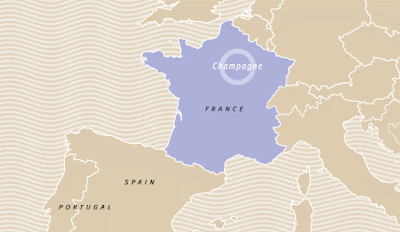As the
holidays approach, sparkling wines come to mind, from inexpensive Proseccos
from Italy and Cavas from Spain, to the myriad California and French bubbly to
the most famous (and expensive) of all—Champagne (sparkling wine from the
Champagne region of France). Nothing
seems to epitomize celebration like Champagne, and when most people consider
buying it they look for the large houses such as Moet et Chandon or Veuve
Cliquot. These producers source their grapes from all over the region and
blend various lots from different areas and even different years to maintain a
consistent flavor and style year after year.
There is,
however, an interesting alternative—the grower champagnes. The vineyards sourced by this type of maker are clustered in a single
village and sometimes even a single vineyard. The wines are crafted to reflect
the terroir of the village, especially if it is a grand cru vineyard.
Grower
Champagnes are usually released younger and often show a lower dosage (the
process of adding sugar before final corking) and occasionally no dosage at
all. Before shipping, most producers disgorge the deposits that collect in the
bottles. The resulting space is filled with a shipping liquor and a tiny bit of
pure cane sugar. The absence of dosage allows the intrinsic qualities of the
wine, such as terroir and minerality, to show through.
The downside
is these wines are more variable year to year compared to the large houses. But
the wines are far more interesting and flavorful. Today there are 19,000
growers in Champagne and about 5000 are making their own wines as the popularity
grows. To find out if a Champagne is a grower Champagne look for the initials RM
(recoltant-manipulant) or ask your wine associate.
While the
number of wines is staggering, here are few examples that you can’t go wrong
with. Champagne Moutard is one of my favorite Champagnes period. It is
from a grand cuvee vineyard and is 100% Pinot Noir. The wine bursts with
brioche, pear, and peach aromas and flavors with beautiful notes of honey,
flowers and minerals. The price is about $43.00—not cheap, but on par with
Veuve or Moet Chandon NVs, and far more interesting.
Champagne Aubrey is made from a majority of Pinot
Meunier with Pinot Noir and Chardonnay as part of the mix. All the fruit is
from Grand Cru vineyards. Fresh apples leap from the glass to your nose, with
hints of cocoa and toast. There are flavors of passion fruit, apricots and
spices, even mango. This wine undergoes malolactic fermentation, giving it
impressive body. A beautiful Champagne for $45.00.
Finally
there is Jacques Copinet, a NV
Champagne that mimics an aged Vintage
Champagne. The aroma is of buttered toast sprinkled with a bit of molasses. On
the palate there is a wonderful balance of power, intense caramel breadiness,
and wonderful elegance. Worth the $50.00
you’ll have to spend.
When it’s
time to celebrate, try one of these Champagnes and have a truly wonderful
experience.


No comments:
Post a Comment